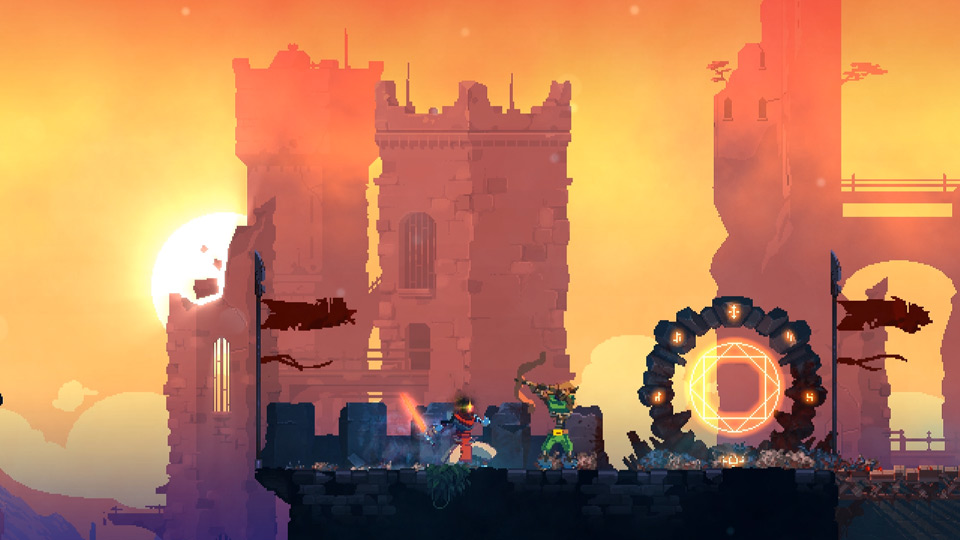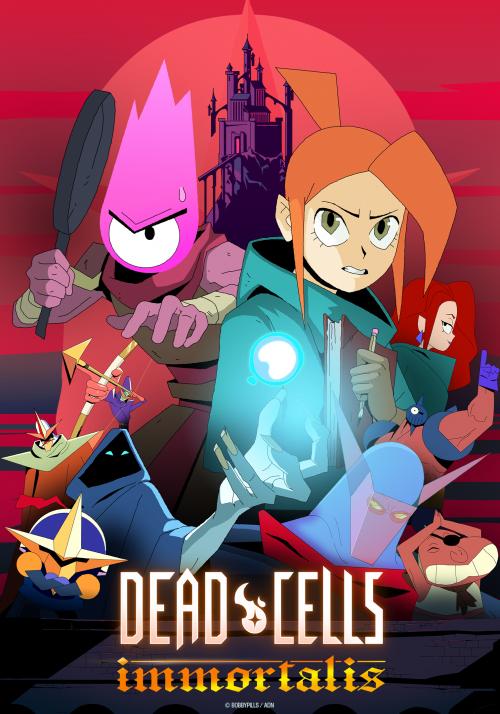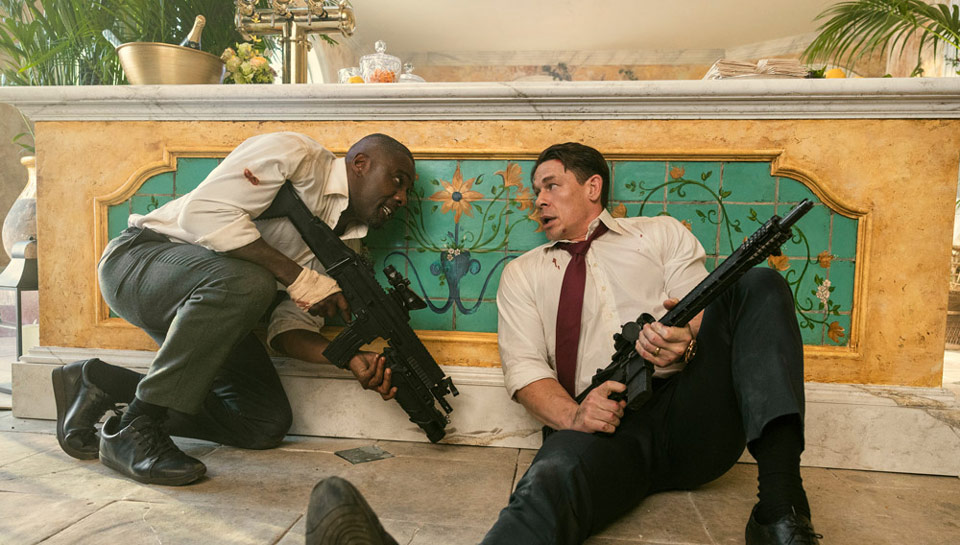A few years ago, when the “Dead Cells’’ video game was already well established, the indie development studio Motion Twin decided to fire the players’ imagination by releasing an animated trailer in traditional 2D. The French studio Bobbypills was chosen to complete the mission. Other “Dead Cells’’ trailers then saw the light of day and Bobbypills began to imagine pushing one step further: “We had a lot of fun exploring the “Dead Cells’’ universe. In just one minute, we managed to tell a story. Back then already, there was a heavy demand for a series from the public,” production director at Bobbypills Jérémie Bonnouvrier remembers. Thomas Vasseur, creative director of the game at Motion Twin agrees: “These trailers gave rise to a desire, an energy. That’s how Bobbypills’ teams came to us with a script.”
Giving the animation studio free rein
How do you adapt a “roguelite” game [a variant of “roguelike” games in which the player can get better between two adventures (runs) and start again with new gameplay possibilities - editor’s note] into an intriguing and fun fiction? This is a daring challenge. “What can you tell about a concept that repeats itself endlessly? Because this genre is inherently repetitive, Yannick Castaing explains as he supervised the project’s production at Bobbypills. The trailers we made for the game sowed the seeds of the series, but then we had to start from scratch. The major challenge was to make an immortal hero who wishes to die, stuck in an infinite loop, likeable. From there, we had to imagine a story…” In this regard, Bobbypills’ creatives were given carte blanche. “You have to put your ego aside and allow others to work on your creation, Thomas Vasseur says with a smile. Let them revisit some of the game’s bosses, like “The Hand of the King”… And it leads to something great…”

Dealing with a tight budget
Bobbypills was able to have fun arranging “Dead Cells’’ in its own way with almost no constraints. “Overall, we had complete freedom to do what we wanted. No one ever told us we were going too far. We dared, threw ideas on the table… The only requests came from the broadcaster, the ADN platform, which wanted an aesthetic with Asian influences to match its editorial policy.” This aesthetic also had to meet the series’ budget. It was indeed impossible to reproduce the silky quality of the previous trailers. “We had 70 minutes of animation to produce for this series. Very quickly, we understood that this work was not economically viable, Jérémie Bonnouvrier says. We had to be smart and find a way to create at lower cost expressive and endearing characters who tell a story. We then made another drastic choice, to stay within budget: not to do any compositing [method of combining visual elements from separate sources into single images, editor’s note]. It’s an atypical decision that we made up for by doing some color grading. We had to either focus on the images’ look or the animation.’’ The decision was made by the Motion Twin teams. Thomas Vasseur believes that design is essentially “less important than animation itself. I preferred that money be put into this work rather than visual details. It's true that the series’ design is very different from the video game’s, but you have to accept that the series has its own visual identity.’’
Finding its own style
Its own visual identity but also narrative identity. Beyond the tight animation budget, the other challenge of this animated adaptation was to find the right balance between respecting the game’s universe and telling a linear story: “In the game, players create their own story on a common ground. However, in a series, you have to guide the audience. Everything must be explicit, Yannick Castaing explains. Viewers are no longer actors; they are spectators. This is surely the most delicate aspect to manage: you have to succeed in taking everyone where you have decided, unlike the game which allows players to widen their own experience.’’ The “Dead Cells: Immortalis’’ series tells the story of a lone hero who wants to die but cannot. He then gradually learns to become less taciturn thanks to a woman, a character who does not exist in the original game... “We have indeed added this female character, named Laure Esposito. A lone hero lacks interest in narrative terms, Yannick Castaing points out. Plus, our hero has lost his memory. Laure Esposito therefore plays the narrator telling the story. The series looks into these questions: what is going on in the head of an immortal? How does he deal with his solitude, his sadness? All this with a distinctive, very impertinent tone, which is Bobbypills’ trademark.’’
Referring to the game
“Dead Cells: Immortalis’’ is a funny and cheeky adult animated series that has managed to stay in line with what gamers had experienced, while finding its own tone, as Thomas Vasseur explains: “If the Bobbypills' teams had simply followed the original video game to the letter, without showing any imagination, the public would have been disappointed! We didn’t want to serve them the same project again.” While the series can speak to a different audience – people who haven’t always got their hands on a controller –, Yannick Castaing notices “an obvious porosity. We don’t have any figures, but we know that a lot of “Dead Cells’’ players watch the series. There are nods to the game here and there.”
Relying on French know-how
This permeability also exists among the forty or so employees at Bobbypills who worked on the series’ production. They too are gamers, for the most part. “It’s visible through the result, Yannick Castaing assures. There is a resonance. Especially since, in some sequences, we also emphasize this particular point by directly transposing the gameplay into the series. It’s necessary to move away from the codes of video games. However, we share the codes of Japanese animation with Motion Twin, and it shows. The bridges between video games and animation are increasingly obvious, especially in France which has know-how in the field. The country has a large community of gamers. It is immersed as much in video games as in Japanese animation. It's our generation, we understand each other. On indie games, there is this shared idea that if we, the teams, manage to laugh about it, it will also be the case for the whole community. If turning video games into animated series work so well in France, I think it is due to the fact that we are big kids paid to make cartoons. There are also very good schools, sometimes hybrid, which allow for this synergy. On the technical level eventually, similar softwares are used to create animated series and video games!’’

Avoiding commercial pitfalls
According to Bobbypills, the series’ success owes a lot to the interactions between the two studios over the years. “All these discussions we had with Motion Twin to create the trailers were crucial. We knew where to aim! For their part, they trusted us because they knew we were not going to break everything. I believe that, originally, you need this complicity, an understanding and exchanges that feed the project’s development upstream…’’ For Thomas Vasseur, the key to a successful adaptation also lies in the state of mind: “You must not think of it as an advertisement for the game, which would display this new weapon or this new power soon to be integrated... An adaptation cannot be marketing. The series must become autonomous and explore the game’s world, even if it annoys some players! That's okay. You need an honest and fair proposal to create a unique product.’’
Imagining the sequel together
Motion Twin and Bobbypills are now working hand in hand on “Windblown’’, the new video game developed by production manager Thomas Vasseur and his team. “In fact, Bobbypills has already made a trailer’’, he rejoices as he can well imagine “Windblown’’ becoming a cartoon one day. As for the “Dead Cells: Immortalis’’ series, the teams say they “don’t know yet if other episodes will be made.’’ “The ones available online are working very well for the moment, Thomas Vasseur points out. A success that gives us nothing but hope…’’
“Dead Cells: Immortalis’’ – Season 1, 10 episodes – available on ADN

With the voices of Antoine Schoumsky, Gérémy Crédeville, Alizée Laffitau…
Directed by Gaspard Sumeire, produced by Bobbypills and ADN, in collaboration with Motion Twin.
The game “Dead Cells’’ benefited from the CNC's Support Fund for Video Games, and the “Dead Cells: Immortalis’’ series from selective aid for preparation and production in animation.





